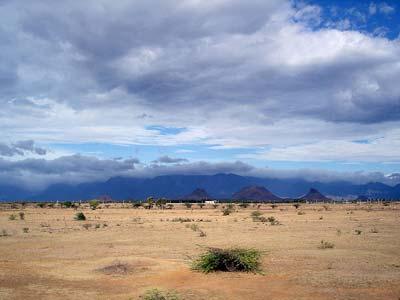Source:
04-23-2009 10:10
In 1953, Peveril Meigs divided desert regions on Earth into three categories according to the amount of precipitation they received. In this now widely accepted system, extremely arid lands have at least 12 consecutive months without rainfall, arid lands have less than 250 millimeters (10 in) of annual rainfall, and semiarid lands have a mean annual precipitation of between 250 and 500 millimeters (10-20 in). Arid and extremely arid lands are deserts, and semiarid grasslands are generally referred to as steppes.
 |
| The Agasthiyamalai hills cut off Tirunelveli (India) from the monsoons, creating a rainshadow region |
Measurement of rainfall alone cannot provide an accurate definition of what a desert is because being arid also depends on evaporation, which depends in part on temperature. For example, Phoenix, Arizona receives less than 250 millimeters (10 in) of precipitation per year, and is immediately recognized as being located in a desert due to its arid adapted plants. However, the North Slope of Alaska's Brooks Range also receives less than 250 millimeters (10 in) of precipitation per year, and is not generally recognized as a desert region.[citation needed]
Potential evapotranspiration supplements the measurement of rainfall in providing a scientific measurement-based definition of a desert. The water budget of an area can be calculated using the formula P-PE±S, wherein P is precipitation, PE is potential evapotranspiration rates and S is amount of surface storage of water. Evapotranspiration is the combination of water loss through atmospheric evaporation and through the life processes of plants. Potential evapotranspiration, then, is the amount of water that could evaporate in any given region. As an example, Tucson, Arizona receives about 300 millimeters, (12 in), of rain per year, however about 2500 millimeters, (100 in), of water could evaporate over the course of a year.[citation needed] In other words, about 8 times more water could evaporate from the region than actually falls. Rates of evapotranspiration in cold regions such as Alaska are much lower because of the lack of heat to aid in the evaporation process.
There are different forms of deserts. Cold deserts can be covered in snow or ice; frozen water unavailable to plant life. These are more commonly referred to as tundra if a short season of above-freezing temperatures is experienced, or as an ice cap if the temperature remains below freezing year-round, rendering the land almost completely lifeless.
Most non-polar deserts are hot in the day and chilly at night (for the latitude) because of the lack of the moderating effect of water. In some parts of the world, deserts are created by a rain shadow effect in which air masses lose much of their moisture as they move over a mountain range; other areas are arid by virtue of being very far from the nearest available sources of moisture.
